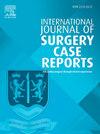手术切除剖宫产相关肌瘤1例
IF 0.6
Q4 SURGERY
引用次数: 0
摘要
棉鞘瘤是一种罕见的手术并发症,涉及海绵等手术遗留物品,构成严重的健康风险和法律挑战。虽然发病率有所下降,但这种疾病仍然难以诊断,通常表现为非特异性症状和重大的医学意义。一例30岁女性剖宫产术后胃肠道症状持续1年半后被诊断为残留缝线,导致手术干预。异物取出后,患者的症状明显改善,这突出了对术后患者进行全面评估的重要性。尽管采取了预防措施,棉丝瘤仍然是一个重大问题,大约每100至3000例手术病例中就有1例发生,特别是在紧急情况下。临床表现差异很大,CT成像对诊断至关重要,可以揭示特征模式,指导手术干预以获得有效治疗。结论本病例强调了棉丝瘤的严重性,需要提高医疗意识以预防其发生。早期诊断和适当的管理是必不可少的,以避免严重的并发症,强调教育卫生保健专业人员关于棉皮瘤作为鉴别诊断的重要性。本文章由计算机程序翻译,如有差异,请以英文原文为准。
Surgical removal of cesarean-related textiloma: A case report
Introduction
Gossypiboma, a rare complication of surgery, involves retained surgical items like sponges, posing serious health risks and legal challenges. Though incidence rates have declined, the condition remains difficult to diagnose, often presenting with nonspecific symptoms and significant medicolegal implications.
Case presentation
A 30-year-old female with persistent gastrointestinal symptoms post-cesarean section was diagnosed with a retained stitch after 1.5 years, leading to surgical intervention. Following the removal of the foreign body, her symptoms improved significantly, highlighting the importance of thorough evaluation in post-surgical patients.
Discussion
Despite preventive measures, gossypibomas remain a significant issue, occurring in approximately 1 in 100 to 3000 surgical cases, particularly in emergency situations. Clinical manifestations can vary widely, and CT imaging is crucial for diagnosis, revealing characteristic patterns that guide surgical intervention for effective treatment.
Conclusion
This case highlights the seriousness of gossypiboma and the need for increased medical awareness to prevent its occurrence. Early diagnosis and appropriate management are essential to avoid severe complications, emphasizing the importance of educating healthcare professionals about gossypibomas as a differential diagnosis.
求助全文
通过发布文献求助,成功后即可免费获取论文全文。
去求助
来源期刊
CiteScore
1.10
自引率
0.00%
发文量
1116
审稿时长
46 days

 求助内容:
求助内容: 应助结果提醒方式:
应助结果提醒方式:


